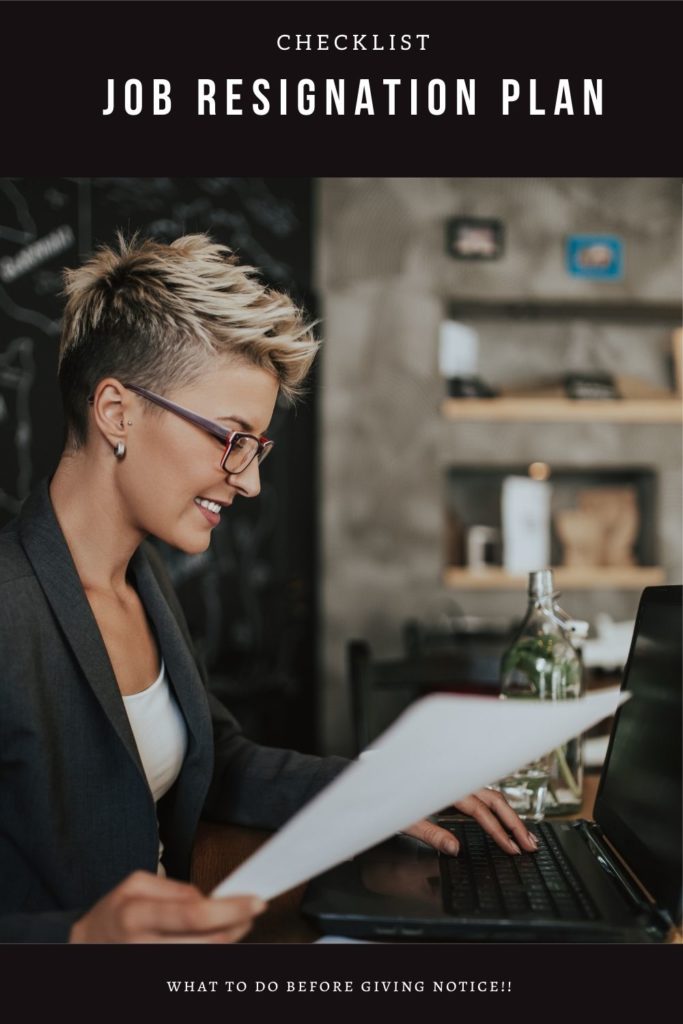Hey there! This post contains affiliate links. Using my links means I earn a commission, which helps me create more rad content. More on affiliates here.
Working with my career coaching clients, they are often STOKED to leave their current job (makes sense, that’s why we’re working together, lol!). And, while they’re excited to quit their current job – they often ask me, “Do you have, like, a job resignation plan? How do I quit my job?”
This is SUCH a great question, and folks usually just type up their notice and call it a day. While I totally support you leaving for greener pastures, I also want you to be 100% ready to go.

Your Job Resignation Plan
Below, I’ve shared my job resignation plan. This plan assumes that you have signed an offer at another company, but it can also work for folks who are quitting without another job lined up.
Let’s dig in!
WARNING!
Some organizations or managers will fire you // process your notice immediately the day you give it. Some orgs do not have their employees stay to work the full 2 weeks.
Because of this, I recommend treading very carefully and getting all the info you can before quitting!

Step 1: Get Client Emails & Contact Info for Professional Connections
This first step will look different for folks, as its largely dependent on your role. The first thing you need to do is make sure you have the emails and contact information of the connections you have made.
Now, let me be clear here. I am *not* telling you to download the 10,000+ contacts on the org’s email subscriber list. Some companies have rules about this!
The goal isn’t to abscond with a large amount of data (that’s… probably illegal), the goal is to get the contact info for the folks you regularly engage with via your work email. Once you no longer have access to that email, you lose those contacts!
Before giving notice, make sure you have this info. This info could also be vendors you’ve hired that you’ve loved, etc.
Step 2: Get Your Data/KPI Info & Work Samples
One of the biggest issues I see when I work with resume clients is that clients can’t remember the numbers or metrics they achieved from their previous position.
IF you’ve increased productivity, designed materials, etc, make sure you have the exact numbers (or details) on what you did at the company. You may think you’ll remember this stuff, but you absolutely won’t!
It KLLS ME inside when I ask a client for this info, and they don’t have it. Get this info NOW!!
Did you cause a product to see increased sales? By how much? Saved the company money? Made the company money?
What data/metrics do you have right now that you can look up? You will *definitely* want this for later on! Take an hour and brain dump all the things you have worked on and what impact you’ve had. Your future self will thank you!!
Step 3: Connect 1:1 with Your Target Colleagues
I’m betting there are likely 1-3 people at your current job that you want to connect with, but haven’t had the chance to. Take the time to reach out now and get a coffee together. Don’t mention that you’re leaving (especially if you haven’t given notice).
Saying something like, “(Name)! I keep meaning to get lunch or Zoom coffee with you! Can we set up a time this week?”
Boom bam done. Networking accomplished!
Step 4: Figure Out Your Vacation Days
A lot of organizations do NOT “pay out” vacation days when you quit. It’s use them or lose them!
Do a little investigative work (the employee manual should have this information), and figure out if you should just take your vacation days before giving notice or if you get a “pay out” for them when you quit.

Step 5: Do You Have Stock Options?
If you have stock options or are vesting at your current job, be sure to talk with an EXTERNAL lawyer or certified financial planner (maybe… both?) to make sure you get all of your stock upon leaving.
Some orgs are shady and have the “Start Date” different from your hiring date for accruing stock, so be sure that you fully understand what’s going on here.
Step 6: Find Your Health Insurance End Date
So, now is the time to do a bit of detective work. When will the health insurance at your new job start? When will the health insurance coverage at your current job end?
Usually, health insurance coverage goes to the last day of the month you’re employed – but it varies! Reach out to the insurance company or HR for details, and you may have to tell a few white lies to get the info. All is fair in love and healthcare coverage!!
This date is important to know, because it may impact the day you choose to give notice.
If there’s a gap between the two (and you live in the USA), you may want to get coverage through COBRA!
Step 7: Research Retirement Accounts
Some companies will require that you “roll over” your retirement accounts upon giving notice, as the company may oversee these. There’s a lot of variance here!
If your current job has a better match plan than your next job, it may make sense to try to max that out before quitting. You’ll have to do more research on the ins and outs of this!
Need Career Strategy Help?
Need job interview help? Feel totally lost when it comes to interviewing for a job you want? I offer interview sessions as a career coach, where I help clients prepare! We go over company research, practice specific interview questions and create planned responses to tough questions! More information is HERE!
More Tips for Growing Your Career!
If you found this blog post helpful, then I bet you would also learn a lot from these blog posts:
- 5 Common Resume Mistakes
- Career Mapping: How to Plan Your Career
- Top 10 Career Mistakes Millennials are Making
More Job Interview Tips in 2021!
I’m excited to be sharing more learnings about job interviewing – and having fun with it – in 2020!. Be sure to subscribe to my newsletter so you don’t miss out!













